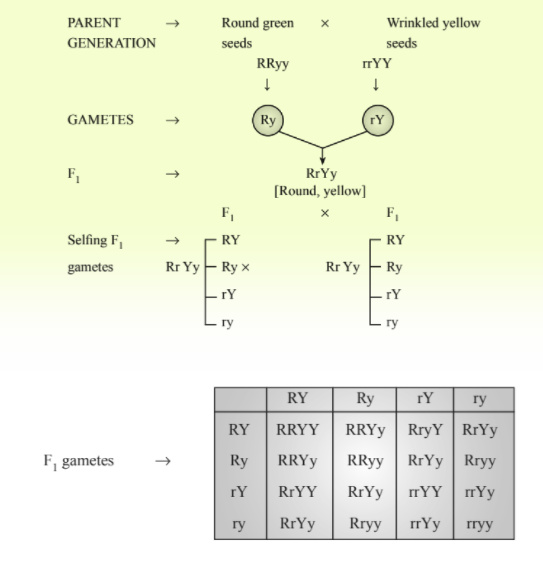Heredity or Hereditary is the process of passing the traits and characteristics from parents to offsprings through genes. The offspring, get their features and characteristics that is genetic information from their mother and father. Heredity and genetics are the reason you look so much like your parents. Genetics is a branch of science that studies the DNA, genes, genetic variation, and heredity in living organisms. Let us learn all about it.
Suggested Videos
Heredity Definition
In the simplest of words, heredity refers to the passing of traits or characteristics through genes from one generation (parent) to the other generation (offspring). Heredity is very evidently seen in sexual reproduction. This is because, in this process, the variation of inherited characteristics is high.
The variation occurs due to some errors in DNA copying. Variation is important because it contributes to the evolution and forms the basis of heredity. Variation is caused due to gene mutations, the interaction of genes with the environment, and various combinations of genetic material. Remember that variation can occur through the asexual reproduction process too. But, these variations are not very noticeable.

(Source – Encyclopedia Britannica)
Gregor Mendel- The Father of Genetics
Acquiring characteristics or traits from one generation to the other is nothing but inheritance. Here, both parents contribute equally to the inheritance of traits. Gregor Mendel, also known as the Father of Genetics, conducted immense research and studies on this inheritance of traits.
He researched on plant breeding and hybridization and conducted his experiments on pea plants to show the inheritance of traits in living organisms.
Browse more Topics under Heredity And Evolution
He observed the pattern of inheritance from one generation to the other in these plants. And thus he came up with Mendel’s Laws of Inheritance, which can be summarized under the following headings:
- Law of Dominance
- Law of Segregation
- Principle of Independent Assortment
Know Some Terms
- Gene – It is the basic unit of inheritance. It consists of a sequence of DNA, which is the genetic material. Genes can mutate and can take two or more alternative forms.
- Alleles – The alternative forms of genes. They affect the same characteristics or traits in alternate forms. They are located on the same place of the chromosome.
- Chromosomes – These are thread-like structures made up of nucleic acids (DNA) and proteins. They are mostly found in the nucleus of the cells. They carry the hereditary or genetic information in the form of genes.
- Genotype – It is the complete heritable genetic identity of an organism. It is the set of alleles that are carried by the organism. It also includes non-expressed alleles.
- Phenotype – It is the description of the actual physical characteristics of an organism or the expressed form of the genotype.
- Dominant alleles – When an allele affects the phenotype of an organism, then it is a dominant allele. Capital letters represent dominant alleles. For example, “T” to express tallness.
- Recessive alleles – An allele that affects the genotype in the absence of the dominant allele is called a recessive allele. Small letters represent recessive alleles. For example – “t” for tallness.
- Homozygous – Each organism has two alleles for every gene (Each chromosome has one each). In homozygous, both the alleles are same. For Example, “TT” is the homozygous expression for tallness trait.
- Heterozygous – If the two alleles are different from each other, then they are heterozygous in nature. For Example, “Tt” is the heterozygous expression for tallness trait.
Mendel’s Experiments
Monohybrid Cross
It is the cross between two plants which have one pair of contrasting characters. For Example, a cross between a tall pea plant and a short (dwarf) plant. The following diagram explains this in detail.

(Source – Pinterest)
Observations & Conclusion
- In the first generation (F1), the progeny were tall. There was no medium height plant.
- In the second generation (F2), 1/4th of the offspring were short and 3⁄4 were tall.
- The Phenotypic ratio in F2 – 3: 1 (3 tall: 1 short)
- The Genotypic ratio in F2 – 1: 2: 1 – (TT: Tt: tt)
- For a plant to be tall, a single copy of “T” is enough. But if a plant has to be short, both the copies should be “t”
- In Tt, ‘T’ is expressed and ‘t’ is suppressed. Hence, the characters ‘T’ is the dominant trait and ‘t’ is the recessive trait.
You can download Heredity and Evolution Cheat Sheet by clicking on the download button below

Dihybrid Cross
It is the cross between two plants which have two pairs of contrasting characters. This takes into consideration alternative traits of two different characters. For example, a cross between one pea plant with round and green seeds and the other pea plant having wrinkled and yellow seeds. The following diagram explains the dihybrid cross in detail.

Observations & Conclusion
- The F1 generation contains 100% hybrid plants. Because, when RRyy crosses with rrYY, all offspring plants are Rr Yy with round and yellow seeds in the first generation. Therefore, the Round and Yellow seeds are the dominant characters.
- In F2, the phenotype ratio is 9:3:3:1 and the genotype ratio is a very complex one.
- This shows that the genes independently inherited.
Solved Questions For You
Q: Which Mendel’s experiments show that traits are inherited independently?
Ans: The Dihybrid cross experiment performed by Mendel performed with the pea plants. In a cross between two plants with two pairs of contrasting characters, the expression of traits occurs independently.








Leave a Reply